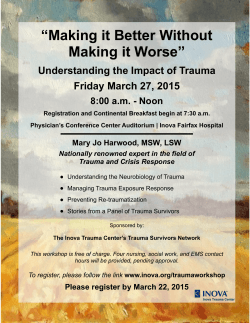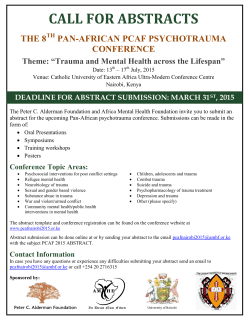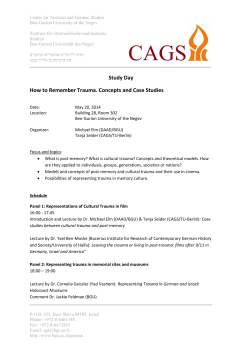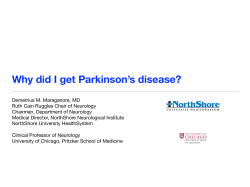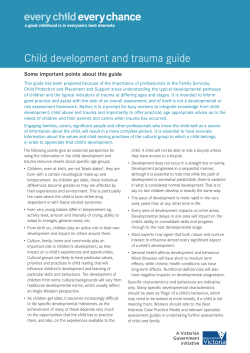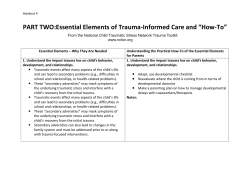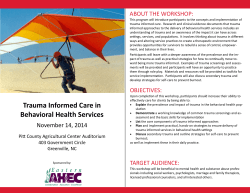
Perinatal Mental Health Seminar Treatment of Complex Trauma and Trauma
Treatment of Complex Trauma and Trauma Informed Care and Service Delivery Perinatal Mental Health Seminar Dr. Cathy Kezelman ©ASCA 2014 “Failure to acknowledge the reality of trauma and abuse in the lives of children, and the long-term impact this can have in the lives of adults, is one of the most significant clinical and moral deficits of current mental health approaches. Trauma survivors still experience stigma and discrimination and un-empathic systems of care. Clinicians and mental health workers need to be well informed about the current understanding of trauma and trauma-informed interventions” Professor Louise Newman The Last Frontier: Practice Guidelines for Treatment of Complex Trauma & Trauma Informed Care and Service Delivery • Launched by Federal Minister for Mental Health (October 2012) • Endorsed by national and international experts • Download or purchase at www.asca.org.au/guidelines Single: Unexpected event - natural disaster, traumatic accident, terrorist attack or single episode of assault, abuse or witnessing of it = PTSD Complex: • Interpersonal • Inescapable • Repeated • Cumulative Emotional Neglect Recurrent physical abuse Physical Neglect Recurrent emotional abuse Mother treated violently One or no parents Contact sexual abuse Family Community Incarcerated household member An alcohol and/or drug abuser in the household Family member chronically depressed, mentally ill, institutionalized, or suicidal Intergenerational Ten Categories are from the Adverse Childhood Experiences (ACE) Study Individual ACE Study: Childhood trauma powerfully impacts mental and physical health ‘a half-century’ later (Felitti, Anda et al, 1998) Initially protective (and often creative) strategies to deal with childhood adversity lose protective function over time and threaten emotional AND physical health in adulthood (Felitti, Anda et al, 1998) Controlling Avoidance People pleasing Numbing Self harming The ACE Score and a Lifetime History of Depression Percent depressed (%) 70 Women Men 60 50 40 30 20 10 0 0 1 2 ACE Score 3 >=4 Percent attempted (%) The ACE Score and the Prevalence of Attempted Suicide 20 15 10 5 0 0 1 2 ACE Score 3 >=4 ACE Score and Drug Abuse Percent With Health Problem (%) 14 ACE Score 12 0 1 2 3 4 >=5 10 8 6 4 2 0 Ever had a drug problem Ever addicted to drugs Ever injected drugs (1) has negative effects across the life-cycle for those who directly experience it (1) intergenerational impacts on the children of parents whose trauma histories are unresolved (Hesse, Main et al, in Solomon & Siegel, 2003) ‘Emotional abuse, loss of caregivers, inconsistency, chronic misattunement principal contributors to psychiatric problems’ (Dozier, Stovall, & Albus, 1999; Pianta, Egeland, & Adam, 1996; van der Kolk, ibid) • Impairs wide range of functioning • Erodes health and wellbeing • Disrupts neural integration • Coping mechanisms affect quality of life • High alert - easily triggered -> cannot `move on’ • deep feelings of insecurity; low self-esteem • poor frustration tolerance; sensitivity to criticism • hyper (physical or psychological agitation) or hypoaroused (shut down – emotionally numb) • substance abuse, self-harming, suicidal, risk-taking behaviours • Anxiety; depression; health problems (emotional and physical); disconnection and shame; isolation; confusion; being `spaced out’; fear of intimacy and new experiences Lifetime patterns of fear and lack of trust; long-term difficulties with emotional regulation/ stress; chronic feelings of helplessness; affects relationships with self, others, the world Conditions conducive to development of selfregulation (beginning with a sense of safety) are crucial to adult survivors of childhood trauma In contrast to the traumatized person who has experienced a sense of safety and well-being prior to onset of the (single-incident) trauma, the survivor of complex trauma does not start with this advantage (Shapiro, 2010) The possibility of underlying trauma (ie even not disclosed) requires immediate attunement to: • attachment issues • the possibility of dissociation `Contact itself is the feared element because it brings a promise of love, safety & comfort that cannot be fulfilled & that reminds [the client] of the abrupt breaches of infancy’ (Hedges, 1997:114; ibid). People often show a `mix’ of `hyper’ (visibly agitated) and `hypo’ (emotionally `shut down’) responses rather than being `either-or’ KEY POINTS: • Both HYPER & HYPO arousal responses can be traumarelated • Failure to understand this leads to inappropriate responses by health professionals • Don’t underestimate capacity of positive interactions to be soothing and validating • Positive relational experiences promote wellbeing - actively assist healing • Prior experience of person is difficult – not person This applies to us all - especially important for people with trauma histories New Paradigm ahead • Minimises re-traumatisation • Recognises many conditions are trauma-related • Current systems inadequate • Applicable to full spectrum of human services delivery (Perry, 2008; Ross and Halpern, 2009) • Awareness of impacts • ‘Do no harm’ approach • Cultural safety • Staff training Safety Trustworthiness Collaboration Empowerment Choice • Commits to and acts upon the core principles • Requires evaluation of all components of the system • Design service systems that ‘accommodate the vulnerabilities of trauma survivors’ (Fallot and Harris, 2009:3) • Delivered in a way that will ‘avoid inadvertent retraumatisation and...facilitate client participation in the services which affect them’ (Fallot and Harris, 2009:3) • Trauma as a defining and organising experience that forms the core of an individual’s identity rather than a single discrete event (Jennings, 2004; Fallot and Harris, 2009) • Understanding client behaviours as adaptive attempts to cope • ‘What happened to the person rather’ than ‘what is wrong with the person’ (Bloom, 2011; FallotandHarris, 2009) • Emphasis on skill building • Stress experienced by staff negatively impacts clients • Staff sensitivities can be ignited in interactions with clients, particularly if staff themselves have unresolved trauma histories • Vicarious trauma (VT) is the `negative transformation in the helper’ from exposure to traumatic material in the context of a helping relationship (Pearlman & Caringi, 2009) Stress breeds stress and attentiveness to wellbeing is the antidote • Professional support line 1300 657 380 Operates 9am-5pm Monday - Sunday EST • Education and training workshops • Resources Factsheets, guidelines, newsletters • Advocacy and health promotion www.asca.org.au Contact: Dr. Cathy Kezelman ckezelman@asca.org.au 0425 812 197
© Copyright 2025

